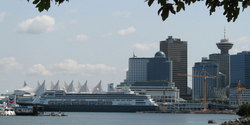
Travelers of distinguished taste have no difficulty finding fitting dining and accommodations. Art lovers will enjoy the museums, shops, and Grandville Island galleries' self-guided tours.
Vancouver city is also a resourceful and environmentally conscious community. Fitness and alternative foods are common place, often office workers are found taking their break as an afternoon jog around Stanley park. Tourists will find that their commute via taxi, the Sky Train and public transport systems efficient and timely.
For first time travelers to Vancouver, the incredible parks, golfing, boating and flight tours create once in a lifetime memories. The world class concerts, sporting events, shopping, sightseeing and amenities always deliver!
Families and couples can find adventures to delight all members and tastes. Whale watching, the sea life at the Vancouver Aquarium in Stanley Park, the Vancouver Art Museum, world renowned sports games, and live "big name" concerts thrill the child in all of us.
To some degree the city is very edgy. Vancouver's rustic bar stops in historic Gas Town, the port weathered brick walls of Hastings Street and the active gay community round-out what could have made Vancouver common place. It is vibrant, bold and right in the middle of the coastal rain forest. An empire of opportunity awaits those who seek to live large!
Population: 550,000
Highlights:
The Vancouver Museum
Stanley Park & Aquarium with Dolphins, Beluga whales, otters & other sea life!
Museum of Anthropology world's finest display of First Nation Artifacts
Grandville Island Public Market
Robson Street, Grandville Street, and Pacific Centre shopping
Gas Town & Yale Town
Canada Place & CN Imax & Cruise Ship Terminal
Golf Courses & Clubhouses
Science World
History:
Throughout the coastal regions of the mainland and surrounding island the First Nations Salish resided within a few thousand years of the last Ice Age. Known to the North Arm of the Fraser River, the Musqueams tribe had settled built their village (many families still do). The Squamish tribes lived and hunted in nearby valleys. Long houses of these tribes were built from hand-hewn planks of Westcoast Red Cedar. Large family emblems, known as totem poles, were also carved into large cedar trees and were raised to represent a family-clan's kinship system, accomplishments, adventures, stories, rights and prerogatives.
(Many examples of these totems are well preserved at the Museum of Anthropology in Vancouver).
With the arrival of Spanish Captain Jose Maria Narvaez 1791 and Captain George Vancouver, shortly after, the exploration of the Strait of Georgia presented the protected potential shipping harbours of today's Vancouver. Most aboriginals remained in the lower area to concentrate and participate in the "trade" industry.
Vancouver's port industry and economy was initially fed by lumber sawmills, the CPR Railway, and saloons (built by Gassy Jack Deighton,in what is Gas Town today). After the Panama Canal was completed in 1914, the Port was able to compete in International Trade and thus thrust Vancouver into the market, center stage. More business would come to the city as word spread in Europe about the "new land's" (British Columbia's) gold rush. Though the city battled with discrimination of Asian migrant workers, the depression and the aftermath of the end of the gold rush, Vancouver's dense and very diverse cultures harmoniously thrive today. Each distinct "town" portrays a strong sense of pride and ethnic charm in commemoration of their ancestor's commitment to a new life.
Climate:
Summer average 20 degrees Celsius
Winter average 6 degrees Celsius
Weather caused by the mountain ranges beyond the city often can turn wet and rainy for days or weeks in the late fall and winter months.
Vancouver Downtown Accommodations
Vancouver Downtown Things to Do
Roedde House Museum, Vancouver Downtown
Ph. 604-684-7040
(Museum)
Bill Reid Gallery of Northwest Coast Art, Vancouver Downtown
Ph. 604-682-3455
(Artists & Fine Art Artisans, Aboriginal arts/ First Nation | First Nations | Galleries/ Exhibits/Shows, Public Art Gallery | Museum)
British Columbia







Ph. 604-662 4719
(Galleries/ Exhibits/Shows | Kids & Teens, Arts and crafts activities | Museum | Theatres | Workshops/Classes, Art Workshops)